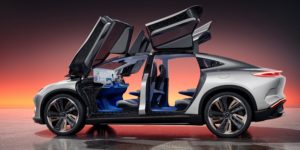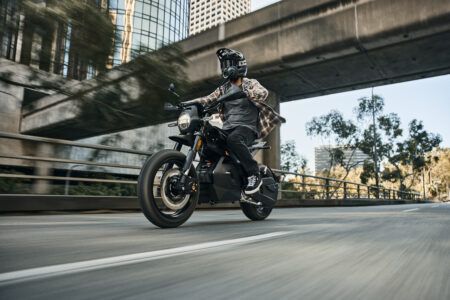Hazim Nada is the man behind Italy’s new ultra-premium electric vehicle brand, Aehra. He tells us that despite electrification offering manufacturers the opportunity to rewrite the automotive design rulebook, many choose not to, and why Aehra is different.
Tell us about your career path and how it led to Aehra
I started my real commercial activity in the energy markets. I was a merchant of crude oil and was engaged in the movement of physical shipments across the globe, covering practically all the corners of the planet. I shipped crude from Latin America to Asia, from North Africa to South Korea. While I was doing so, some of the markets I was engaged in, began shifting directly as a result of the transition [to electric vehicles]. So my awareness of the growth of EVs was a gradual but profound one. At the same time, my passion for piloting and parachuting had resulted in the building of a substantial recreational/training vertical wind tunnel facility in Milan. And the know how in that project, and my observations on the EV reality translated into Aehra.
The EV start up space is starting to look a little crowded – what makes Aehra’s approach to the EV space different?
The project started around April 2019 with the question, Why is it that all electric vehicles still have the shapes of internal combustion engine vehicles? Anybody who knows a little bit of aerodynamics will know that the main pressure point of the frontal section of any vehicle is the angle between the windshield and the front hood. I read up on the history of automotive design and found that in the 1920s and 30s, people were experimenting with alternative shapes and aerodynamics for the automotive sector. There was the Schlörwagen in Germany, for example, which looked like an egg. There is a series of very different shapes that people were considering, that were abandoned, not on the principle of equal dynamics or stability, but primarily because the needs of the internal combustion engine [ICE] did not match with those shapes. So, from a first-principal analysis, the shapes of the vehicles we have today, are not the optimal shapes. Also, if you take into consideration the user experience, they’re still not the optimal shapes. We’ve seen these for decades now with without any significant change, and they’re very boring. Why is it, now that we’re shifting away from ICEs, we are still using the design that has spun out of the needs of such engine? That is the main point we’re addressing.

Is Aehra looking at other aspects of EV technology, such as powertrain or battery?
Over the last three to four years, an ecosystem of suppliers who have developed products that far exceeds what’s currently being produced by the OEMs has appeared. So manufacturers who before just developed battery cells now produce battery packs that integrate several of the thermal management system components that are required. Same for the E-axles; in the past very few electric motor suppliers could match the needs of efficiency that an EV has to have. Now you have an ecosystem of 800-volt architecture where the E-motor is integrated with gears and inverters into packages that are extremely efficient and perform well. So why should we then go and reinvent such components? So we’re making the same mistake of others and unnecessarily adding another name to that side of things. Aehra is focusing on the things we believe the market needs to see shift in, which is the shapes and the resulting macro architecture.
Filippo Perini [from Lamborghini] is the chief design officer at Aehra. Can you talk us through the changes you’ve made to the design of the car and why you did them?
The prototype was a work in progress for a long time, so what we’ve recently presented is something that’s extremely close to production. We don’t envisage any significant change moving forward. The guiding principles have been efficiency and aerodynamics, but also Italian design functionality. So, we did not want to externalize aerodynamics at the cost of aesthetics and beauty. What we think we have is a perfect balance of aesthetics with functionality, which in the end is really the summary of Italian design.

There does seem to have been a number of EV start-ups appearing recently. What challenges are faced by new companies entering this space?
There have been some challenging winds that have blown in over the last few months, and quite a few start-ups are in difficulty. Until recently, the industry demanded a start-up internalize a lot of the technology, which has made the cost of development extremely high. So obviously, some of the start-ups, especially in the US, are facing severe difficulty now, and generally this is casting a cloud over the market sentiment. Having said that, we believe our approach significantly minimizes such risks. At the same time, we’re coming across with tangible, visible, USPs in our products. We have something that does not exist today and the approach to bring it to market is very pragmatic. We’re very focused on the key idea and do not deviate attention into side activities that increase the cost and therefore the risk.
What’s the timeline for production?
We’re aiming for the end of 2025. The key factors are primarily the battery pack solution that we are working on with our suppliers, and the closing the capital arrangement. At the moment I’m actively engaged with fundraising and the negotiations with the suppliers, and not so involved on the design elements at the moment. We have already developed Aehra’s key design language and the design elements for the vehicles, so the rest is in the hands of Filippo and his team.
How have these ideas of radically changing what people expect a car to look like been received? What has the feedback been like from the industry so far?
It’s been remarkably positive, and we’re getting exactly the kind of response we wanted, in the sense that when people see the vehicle, they don’t understand that it’s an SUV. The initial reaction is, Oh, it looks like a sedan or a supercar but it isn’t. What is this? And that’s what we wanted to happen, what we hoped to communicate. If we hadn’t puzzled people then that would have meant we were too close to what’s already out there.

Is there anything about the EV industry as a whole that that you would like to change? Attitudes that you would like to see disappear or be replaced?
The legacy thinking with regards to the ICE simply needs to go away. When we started, we overlapped images of all the electric sedans that we could see in the market or that were in development. By placing their silhouettes on top of each other, it soon became impossible to discern which was which. They were identical, basically replicating the look of existing ICE vehicles. As I said before, we are being very pragmatic, we’re not trying to reinvent every piece of the vehicle. But the macro architecture can very easily be changed, it’s not an impossible task, you just need to work on the solutions. Which is why we don’t understand why people are still pursuing these old types of shapes. They’re sacrificing cabin space at the expense of a frunk that nobody uses and giving the customer something that they’ve seen over and over and over again. People are developing so many things in terms of subcomponents, but nobody’s looking at the bigger picture, the direct consumer experience. And what we’re doing is really addressing that.
You hold an MS in Theoretical Physics from the University of Cambridge and a PhD in Applied Mathematics from Imperial College London. Did any of that feed into Aehra’s approach?
Well, theoretical physics, especially the type I was engaged in, is concerned with going back to the primordial principles that needs to be satisfied. And I think that mindset was inherited by Aehra, because we’re going back to the exterior body of the vehicle and considering what primordial principles are required. And it’s the same with the car’s cabin space as well. So in that sense, yes, my background in theoretical physics has had a. bearing, but not so much the mathematical knowledge, it’s more the modus operandi: seek out the first principles, and then apply them.





